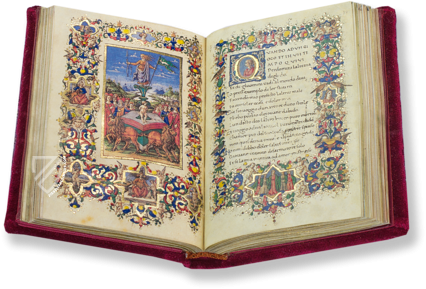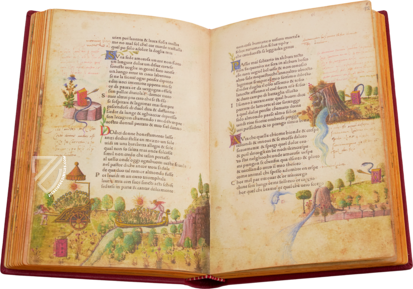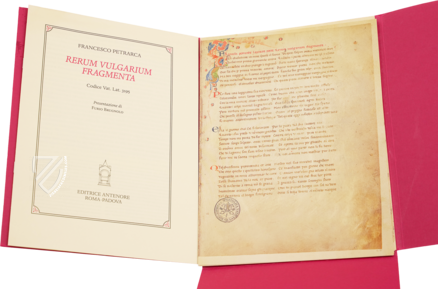Petrarca: Trionfi - Florence Codex
(3,000€ - 7,000€)
The Trionfi of Francesco Petrarch (1304–1374) is a literary bestseller of the Renaissance. In it, the famous poet of the Italian Early Renaissance sings of the triumph of love, chastity, and glory, the triumph of time, the triumph of death over time, and the triumph of eternity, thus setting forth his humanistic worldview entirely in the spirit of his time. The Biblioteca Medicea Laurenziana in Florence preserves one of the most beautiful and precious copies of this opus magnum, masterfully illuminated in the mid-15th century by the talented Florentine illuminator Apollonio di Giovanni (1415–1465) for an unknown patron. Twenty-three ornate miniatures, whose quality is in no way inferior to the great panel paintings of the Renaissance, a lavish use of gold and opulent floral borders make the manuscript a golden masterpiece of the Italian Quattrocento.
Petrarca: Trionfi
The poetry of Francesco Petrarca belongs among the most significant examples of Italian literature and was a role model for the love poetry of countless famous poets worldwide. The Triumphs, whose Italian name reads Trionfi, are a famous example of the poetry of Petrarch. His tale of the Triumphs particularly shows its advantage in the so-called Florentine Codex. The extravagant illuminated codex contains miniatures and marginal decorations of incomparable quality. It comprises a Renaissance artwork of inconceivable quality.
Petrarch’s Work
Francesco Petrarca was an Italian poet and historian. He is considered to be a founder of Renaissance humanism and, along with Dante Alighieri and Boccaccio, one of the most important representatives of early Italian literature. The term Petrarchism comes from his names, which designated a widespread school of thought within European love poetry up to the 17th century. His works influenced world literature over the centuries. The Trionfi, one of the most popular poems worldwide, are a tale of the triumph of the good and the beautiful. Six triumphs that were sung about include, the triumph of love, of chastity, of fame, of time, the triumph of death over time, and the triumph of eternity.
Breathtaking Book Decoration
The tale of the Triumphs became an unforgettable masterpiece of 15th century Italian book art through the unbelievably rich and high quality book illustrations. The manuscript contains 23 full-page miniatures and moreover, each page of the book is embellished with heady marginal depictions. The breathtaking miniatures are reminiscent of the painting of the Italian Renaissance, e.g. the panel paintings of Raphael and Botticelli. The extremely rich marginal embellishments are particularly charming. They show an unbelievable variety of patterns. Flowers and plants twine along page margins, in the middle of which depictions of fruits as well as small depictions of people are found in golden frames. The gifted miniaturist Apollonio di Giovanni di Tommaso, one of the most beloved book artists of the Italian Renaissance, is probably responsible for the design of the work. Today the valuable original codex is stored in the Biblioteca Medicea Laurenziana in Florence.
Codicology
- Alternative Titles
- Triunfos de Petrarca
Il Trionfi di Francesco Petrarca
Petrarch's Triumphs
Les Triomphes de Petrarque
Francesco Petrarca, I Trionfi
Petrarca: Triumphe
Strozzi Petrarch - Size / Format
- 102 pages / 21.7 × 13.7 cm
- Origin
- Italy
- Date
- Mid 15th century
- Epochs
- Style
- Genre
- Language
- Script
- Calligraphic mercantesca
- Illustrations
- 23 full-page miniatures
- Content
- Petrarca's Trionfi
- Artist / School
- Francesco Petrarca (1304–1374) (author)
Miniaturist: Apollonio di Giovanni di Tommaso (1415–1465), also known as "Master of the Jarves Cassone" (illuminator)
Petrarca: Trionfi - Florence Codex
Triumphus Mortis: Triumph of Death
Although Petrarch only ascribes an actual triumphal chariot to Love, most illustrators chose to apply the device to all of the Trionfi, including Death, who is depicted here holding a scythe and standing on top of a black chariot resembling a hearse drawn by two oxen with rings in their noses. Death’s scythe and the head of one of the oxen exceed the red, white, and green frame making it appear as though Death’s triumphal procession will continue off the page.

Petrarca: Trionfi - Florence Codex
Coluccio Salutati
One of the most important political and cultural leaders of Renaissance Florence before the rise of the Medici was Coluccio Salutati (1331–1406). He was a humanist, notary, and served as Chancellor of the Florentine Republic for decades. One of the most celebrated Italian politicians of his day, he was also a scholar and humanist patron with a personal library of more than 800 books.
Salutati is depicted in profile as an elderly man who it slightly hunched forward and holding an open book while three more books lie at his feet, one leaning against the platform on which he stands. Stylishly dressed in red from his cap to his boots, he is dressed in the kind of loose flowing pleated robes that were in style during the late 14th and 15th centuries.

#1 Francesco Petrarca, I Trionfi
Language: Italian
(3,000€ - 7,000€)
- Treatises / Secular Books
- Apocalypses / Beatus
- Astronomy / Astrology
- Bestiaries
- Bibles / Gospels
- Chronicles / History / Law
- Geography / Maps
- Saints' Lives
- Islam / Oriental
- Judaism / Hebrew
- Single Leaf Collections
- Leonardo da Vinci
- Literature / Poetry
- Liturgical Manuscripts
- Medicine / Botany / Alchemy
- Music
- Mythology / Prophecies
- Psalters
- Other Religious Books
- Games / Hunting
- Private Devotion Books
- Other Genres
- Afghanistan
- Armenia
- Austria
- Belgium
- Belize
- Bosnia and Herzegovina
- China
- Colombia
- Costa Rica
- Croatia
- Cyprus
- Czech Republic
- Denmark
- Egypt
- El Salvador
- Ethiopia
- France
- Germany
- Greece
- Guatemala
- Honduras
- Hungary
- India
- Iran
- Iraq
- Israel
- Italy
- Japan
- Jordan
- Kazakhstan
- Kyrgyzstan
- Lebanon
- Liechtenstein
- Luxembourg
- Mexico
- Morocco
- Netherlands
- Palestine
- Panama
- Peru
- Poland
- Portugal
- Romania
- Russia
- Serbia
- Spain
- Sri Lanka
- Sweden
- Switzerland
- Syria
- Tajikistan
- Turkey
- Turkmenistan
- Ukraine
- United Kingdom
- United States
- Uzbekistan
- Vatican City
- A. Oosthoek, van Holkema & Warendorf
- Aboca Museum
- Ajuntament de Valencia
- Akademie Verlag
- Akademische Druck- u. Verlagsanstalt (ADEVA)
- Aldo Ausilio Editore - Bottega d’Erasmo
- Alecto Historical Editions
- Alkuin Verlag
- Almqvist & Wiksell
- Amilcare Pizzi
- Andreas & Andreas Verlagsbuchhandlung
- Archa 90
- Archiv Verlag
- Archivi Edizioni
- Arnold Verlag
- ARS
- Ars Magna
- ArtCodex
- AyN Ediciones
- Azimuth Editions
- Badenia Verlag
- Bärenreiter-Verlag
- Belser Verlag
- Belser Verlag / WK Wertkontor
- Benziger Verlag
- Bernardinum Wydawnictwo
- BiblioGemma
- Biblioteca Apostolica Vaticana (Vaticanstadt, Vaticanstadt)
- Bibliotheca Palatina Faksimile Verlag
- Bibliotheca Rara
- Boydell & Brewer
- Bramante Edizioni
- Bredius Genootschap
- Brepols Publishers
- British Library
- C. Weckesser
- Caixa Catalunya
- Canesi
- CAPSA, Ars Scriptoria
- Caratzas Brothers, Publishers
- Carus Verlag
- Casamassima Libri
- Centrum Cartographie Verlag GmbH
- Chavane Verlag
- Christian Brandstätter Verlag
- Circulo Cientifico
- Club Bibliófilo Versol
- Club du Livre
- CM Editores
- Collegium Graphicum
- Collezione Apocrifa Da Vinci
- Comissão Nacional para as Comemorações dos Descobrimentos Portugueses
- Coron Verlag
- Corvina
- CTHS
- D. S. Brewer
- Damon
- De Agostini/UTET
- De Nederlandsche Boekhandel
- De Schutter
- Deuschle & Stemmle
- Deutscher Verlag für Kunstwissenschaft
- DIAMM
- Droz
- E. Schreiber Graphische Kunstanstalten
- Ediciones Boreal
- Ediciones Grial
- Ediclube
- Edições Inapa
- Edilan
- Editalia
- Edition Deuschle
- Edition Georg Popp
- Edition Leipzig
- Edition Libri Illustri
- Editiones Reales Sitios S. L.
- Éditions de l'Oiseau Lyre
- Editions Medicina Rara
- Editorial Casariego
- Editorial Mintzoa
- Editrice Antenore
- Editrice Velar
- Edizioni Edison
- Egeria, S.L.
- Eikon Editores
- Electa
- Emery Walker Limited
- Enciclopèdia Catalana
- Eos-Verlag
- Ephesus Publishing
- Ernst Battenberg
- Eugrammia Press
- Extraordinary Editions
- Fackelverlag
- Facsimila Art & Edition
- Facsimile Editions Ltd.
- Facsimilia Art & Edition Ebert KG
- Faksimile Verlag
- Feuermann Verlag
- Folger Shakespeare Library
- Franco Cosimo Panini Editore
- Friedrich Wittig Verlag
- Fundación Hullera Vasco-Leonesa
- G. Braziller
- Gabriele Mazzotta Editore
- Gebr. Mann Verlag
- Gesellschaft für graphische Industrie
- Getty Research Institute
- Giovanni Domenico de Rossi
- Giunti Editore
- Graffiti
- Grafica European Center of Fine Arts
- Guido Pressler
- Guillermo Blazquez
- Gustav Kiepenheuer
- H. N. Abrams
- Harrassowitz
- Harvard University Press
- Helikon
- Hendrickson Publishers
- Henning Oppermann
- Herder Verlag
- Hes & De Graaf Publishers
- Hoepli
- Holbein-Verlag
- Houghton Library
- Hugo Schmidt Verlag
- Idion Verlag
- Il Bulino, edizioni d'arte
- ILte
- Imago
- Insel Verlag
- Instituto de Estudios Altoaragoneses
- Instituto Nacional de Antropología e Historia
- Istituto dell'Enciclopedia Italiana - Treccani
- Istituto Ellenico di Studi Bizantini e Postbizantini
- Istituto Geografico De Agostini
- Istituto Poligrafico e Zecca dello Stato
- Italarte Art Establishments
- Jan Thorbecke Verlag
- Johnson Reprint Corporation
- Josef Stocker
- Josef Stocker-Schmid
- Jugoslavija
- Karl W. Hiersemann
- Kasper Straube
- Kaydeda Ediciones
- Kindler Verlag / Coron Verlag
- Kodansha International Ltd.
- Konrad Kölbl Verlag
- Kurt Wolff Verlag
- La Liberia dello Stato
- La Linea Editrice
- La Meta Editore
- Lambert Schneider
- Landeskreditbank Baden-Württemberg
- Leo S. Olschki
- Les Incunables
- Liber Artis
- Library of Congress
- Libreria Musicale Italiana
- Lichtdruck
- Lito Immagine Editore
- Lumen Artis
- Lund Humphries
- M. Moleiro Editor
- Maison des Sciences de l'homme et de la société de Poitiers
- Manuscriptum
- Martinus Nijhoff
- Maruzen-Yushodo Co. Ltd.
- MASA
- Massada Publishers
- McGraw-Hill
- Metropolitan Museum of Art
- Militos
- Millennium Liber
- Müller & Schindler
- Nahar - Stavit
- Nahar and Steimatzky
- National Library of Wales
- Neri Pozza
- Nova Charta
- Oceanum Verlag
- Odeon
- Orbis Mediaevalis
- Orbis Pictus
- Österreichische Staatsdruckerei
- Oxford University Press
- Pageant Books
- Parzellers Buchverlag
- Patrimonio Ediciones
- Pattloch Verlag
- PIAF
- Pieper Verlag
- Plon-Nourrit et cie
- Prestel Verlag
- Princeton University Press
- Prisma Verlag
- Priuli & Verlucca, editori
- Pro Sport Verlag
- Propyläen Verlag
- Pytheas Books
- Quaternio Verlag Luzern
- Reales Sitios
- Recht-Verlag
- Reichert Verlag
- Reichsdruckerei
- Reprint Verlag
- Riehn & Reusch
- Roberto Vattori Editore
- Rosenkilde and Bagger
- Roxburghe Club
- Salerno Editrice
- Saltellus Press
- Sandoz
- Sarajevo Svjetlost
- Schöck ArtPrint Kft.
- Schulsinger Brothers
- Scolar Press
- Scrinium
- Scripta Maneant
- Scriptorium
- Shazar
- Siloé, arte y bibliofilia
- SISMEL - Edizioni del Galluzzo
- Sociedad Mexicana de Antropología
- Société des Bibliophiles & Iconophiles de Belgique
- Soncin Publishing
- Sorli Ediciones
- Stainer and Bell
- Studer
- Styria Verlag
- Sumptibus Pragopress
- Szegedi Tudomànyegyetem
- Taberna Libraria
- Tarshish Books
- Taschen
- Tempus Libri
- Testimonio Compañía Editorial
- Thames and Hudson
- The Clear Vue Publishing Partnership Limited
- The Facsimile Codex
- The Folio Society
- The Marquess of Normanby
- The Richard III and Yorkist History Trust
- Tip.Le.Co
- TouchArt
- TREC Publishing House
- TRI Publishing Co.
- Trident Editore
- Typis Regiae Officinae Polygraphicae
- Union Verlag Berlin
- Universidad de Granada
- University of California Press
- University of Chicago Press
- Urs Graf
- Vallecchi
- Van Wijnen
- VCH, Acta Humaniora
- VDI Verlag
- VEB Deutscher Verlag für Musik
- Verlag Anton Pustet / Andreas Verlag
- Verlag Bibliophile Drucke Josef Stocker
- Verlag der Münchner Drucke
- Verlag für Regionalgeschichte
- Verlag Styria
- Vicent Garcia Editores
- W. Turnowski Ltd.
- W. Turnowsky
- Waanders Printers
- Wiener Mechitharisten-Congregation (Wien, Österreich)
- Wissenschaftliche Buchgesellschaft
- Wissenschaftliche Verlagsgesellschaft
- Wydawnictwo Dolnoslaskie
- Xuntanza Editorial
- Zakład Narodowy
- Zollikofer AG

































































